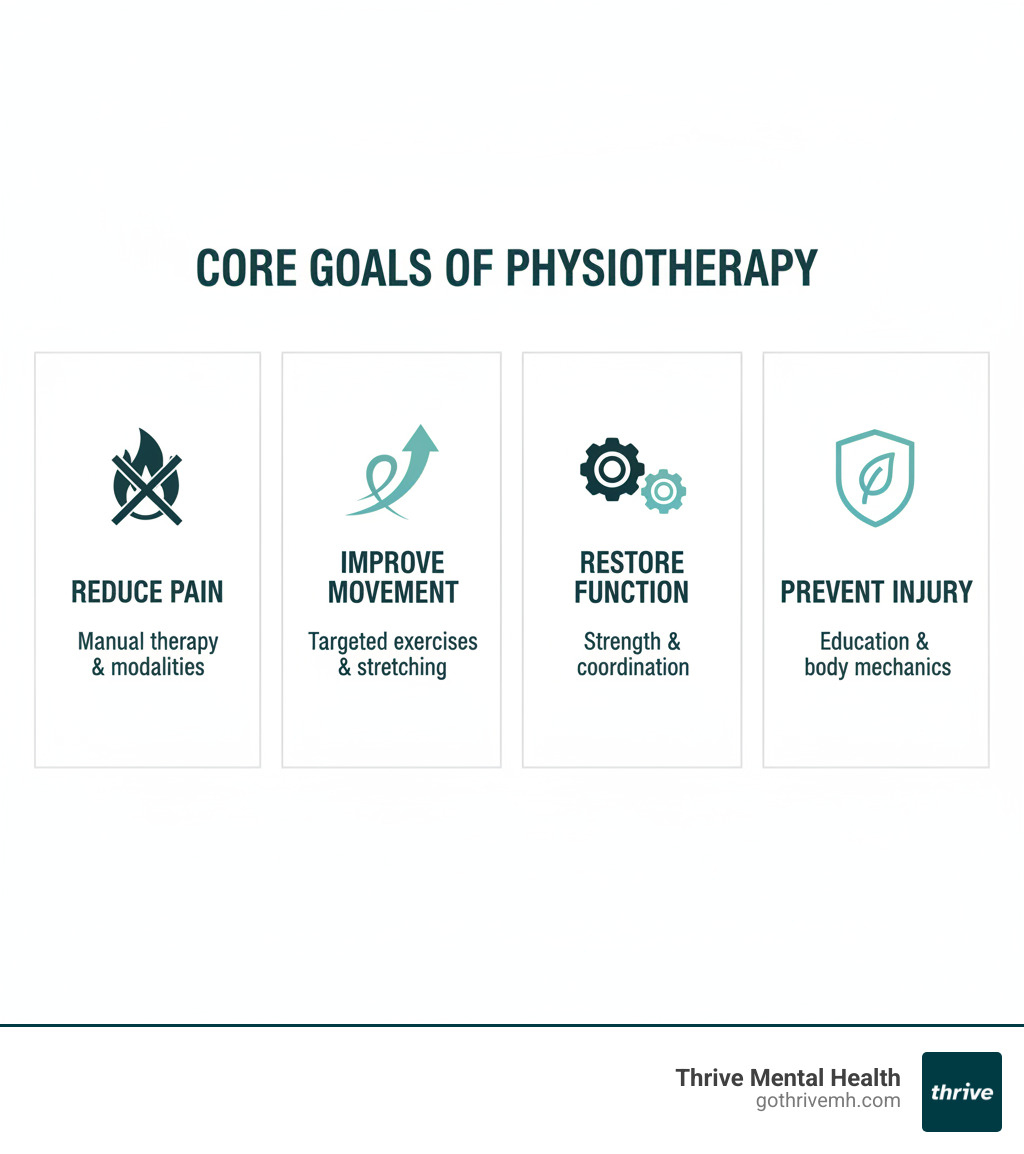Physical Therapy vs. Physiotherapy: Unpacking the Benefits

Physiotherapy: Top 3 Benefits for You
Why Physiotherapy Matters for Your Body—and Your Mind
Physiotherapy is a healthcare profession focused on restoring movement, reducing pain, and improving quality of life through hands-on treatment, exercise, and patient education. Whether you’re recovering from surgery, managing chronic pain, or dealing with a sports injury, it helps you regain function and independence without relying solely on medication.
What physiotherapy addresses:
- Pain management – Reduces discomfort from injuries, arthritis, or chronic conditions
- Movement restoration – Rebuilds strength, flexibility, and coordination
- Injury prevention – Teaches proper body mechanics to avoid future problems
- Post-surgery recovery – Speeds healing and restores function after operations
- Chronic condition support – Manages symptoms of conditions like stroke or Parkinson’s
Physiotherapy is known by different names worldwide. In the United States, practitioners are called physical therapists, while many other countries use the term physiotherapist. The profession itself is identical—both focus on the science of movement.
Physiotherapy’s roots trace to ancient Greece, but the modern profession emerged in the early 20th century, driven by the need to rehabilitate soldiers after World War I. Today, it’s a vital global healthcare field.
Many don’t realize the deep link between physical recovery and mental health. Chronic pain and limited mobility can lead to anxiety, depression, and isolation. Physiotherapy doesn’t just heal your body—it empowers you to reclaim your life, rebuilding confidence and joy.
I’m Anna Green, LMHC, LPC, Chief Clinical Officer at Thrive Mental Health. I’ve seen countless clients whose physical pain deeply affected their emotional well-being—and how addressing both through integrated care, including physiotherapy, made all the difference. Understanding this intersection is central to true recovery.

What Is Physiotherapy? Unpacking the Core Concepts
Physiotherapy is the science of getting you moving again. It’s a healthcare profession that takes a holistic view of your well-being, understanding that physical challenges like pain or stiffness also affect your emotions and quality of life. It’s not just about fixing a problem; it’s about empowering you to take an active role in your recovery and long-term health, helping you get back to the activities that matter.
Defining Physiotherapy and Its Primary Goal
According to World Physiotherapy, the profession is “concerned with human function and movement and maximising physical potential.” In simple terms, physiotherapists help you move better and live better. The practice uses physical approaches—like exercise, manual therapy, and education—to restore your physical, psychological, and social well-being.
At its core, physiotherapy is about movement. As movement experts, physiotherapists assess, diagnose, and treat movement disorders. Their primary goal is to restore function and optimize your health, focusing on long-term improvement rather than temporary symptom relief. You can explore more about the scientific foundations of this practice here: Scientific research on the description of physical therapy.
Physiotherapist vs. Physical Therapist: Is There a Difference?
What’s the difference between a physiotherapist and a physical therapist? The answer is simple: there isn’t one. They’re the same profession with different names depending on where you are in the world.
In Florida and across the United States, we say physical therapist. In Canada, the UK, Australia, and many other countries, they say physiotherapist. Both are highly trained healthcare professionals who are experts in human movement, function, and rehabilitation. The only difference is the name on the door.
A Brief History of the Profession
Physiotherapy has ancient roots, with figures like Hippocrates advocating for massage and manual therapy. The modern profession, however, took shape in the 19th and early 20th centuries. In 1813, Per Henrik Ling founded the Royal Central Institute of Gymnastics in Sweden, focusing on systematic exercise and manipulation.
The real turning point was World War I, which created an overwhelming need for rehabilitation services for injured soldiers. This demand led to the formalization of the profession, with “reconstruction aides” specializing in physical healing methods.
Professional organizations soon formed, such as the Chartered Society of Physiotherapy in the UK (1894) and the American Physical Therapy Association in the US (1921). These bodies established educational standards and advanced research, helping the profession evolve into the diverse, evidence-based field it is today. You can learn more about this evolution here: History of the Chartered Society of Physiotherapy.
Who Benefits from Physiotherapy? Conditions and Applications
Physiotherapy isn’t just for athletes or people recovering from major surgery. Almost anyone can benefit from it at some point. Whether you’re dealing with persistent back pain, recovering from a stroke, or helping your child with developmental delays, physiotherapy offers practical solutions to restore movement and improve quality of life.
I’ve seen how physical limitations can trap people in cycles of frustration and isolation. When you can’t move the way you used to, it affects everything—your mood, your relationships, your sense of independence. That’s why understanding who benefits from physiotherapy matters. It’s about helping you reclaim your life.

Common Conditions Treated with Physiotherapy
The scope of physiotherapy is remarkably broad. Musculoskeletal injuries are common, including chronic low back pain, neck pain from poor posture, carpal tunnel syndrome, and acute sprains. Post-surgery rehabilitation is also critical, as physiotherapists design programs to help you regain strength and mobility after procedures like knee replacements or spinal fusions, speeding up recovery.
For neurological conditions like stroke, Parkinson’s disease, or multiple sclerosis, physiotherapy can be transformative, improving balance, coordination, and overall independence. It also addresses cardiopulmonary issues like asthma, pelvic floor dysfunction (e.g., incontinence, pelvic pain), sports injuries like ACL tears, and helps with arthritis management by maintaining joint mobility and reducing pain.
The Role in Rehabilitation and Recovery
Physiotherapy acts as a bridge from injury back to daily life. It’s both reactive and preventive. After surgery or injury, targeted exercise programs reduce swelling, manage pain, and rebuild strength, often cutting recovery time. By analyzing your movement patterns, physiotherapists also teach you proper body mechanics to prevent future injuries.
For chronic pain management, physiotherapy offers a lifeline beyond medication, using exercise and manual therapy to provide relief. Improving mobility is another life-changing aspect, helping people with balance or walking difficulties regain independence and confidence. Specialized return-to-work programs also help individuals safely get back to their jobs after an injury.
Benefits Across the Lifespan
Physiotherapy adapts to every stage of life. For children, it addresses developmental delays, cerebral palsy, or scoliosis. In adulthood, it manages everything from acute injuries to chronic conditions and supports women through pre- or post-natal care. For older adults, it focuses on fall prevention, manages age-related conditions like osteoporosis, and maintains the strength needed to stay active. For neurodegenerative conditions, it helps manage physical symptoms, potentially improving both cognition and mental health.
If you’re struggling with physical limitations affecting your emotional well-being, addressing both is essential. At Thrive, we understand this connection. Learn more about our approach to comprehensive mental health support that considers your whole person.
Your Physiotherapy Journey: What to Expect
Starting physiotherapy is a partnership. Your therapist will create a personalized treatment plan that fits your specific goals and lifestyle, and you’ll be an active participant in your recovery.
Before your first appointment, check your insurance coverage. Most plans from providers like Cigna, Optum, and Florida Blue cover physiotherapy. Here in Florida, direct access laws allow you to see a physiotherapist without a doctor’s referral. However, some plans may still require one for reimbursement, so it’s wise to call your provider first. You can also verify your insurance in just 2 minutes to understand your options.
The First Session: Assessment and Goal Setting
Your first appointment is a comprehensive evaluation. Your therapist will discuss your medical history, lifestyle, and symptoms. This is followed by a physical examination to assess your posture, range of motion, strength, and movement patterns. Based on this, your physiotherapist will provide a clear diagnosis and work with you to set meaningful goals. Your goals will shape your customized treatment plan, which will evolve as you progress.
Common Treatment Techniques
Physiotherapists use a variety of techniques, often in combination:
- Manual therapy: Hands-on techniques like massage and joint mobilization to reduce pain and improve movement.
- Therapeutic exercise: Prescribed movements designed to address specific weaknesses, such as nerve gliding for sciatica or core strengthening for back pain.
- Electrotherapy: Modalities like TENS (Transcutaneous Electrical Nerve Stimulation) use gentle electrical currents to relieve pain.
- Therapeutic ultrasound: Uses sound waves to promote healing in soft tissues and reduce inflammation.
- Heat and cold therapy: Warm packs relax muscles, while ice packs reduce pain and swelling after an injury.
- Kinesiology taping: Elastic tape provides support and reduces pain without restricting movement.
- Radial shockwave therapy: Uses acoustic waves to stimulate healing for chronic tendon issues like plantar fasciitis.
The Rise of Telehealth in Physiotherapy
Physiotherapy has acceptd the digital age. Virtual consultations allow your therapist to assess your movement, demonstrate exercises, and monitor your progress via video call. This is incredibly convenient if you have mobility challenges, live in a rural area, or have a busy schedule.
Remote monitoring with apps and wearable devices allows your therapist to track your progress between sessions and adjust your program in real-time. Research, including studies on telerehabilitation services for stroke, shows that virtual care can be as effective as in-person treatment for many conditions. While it doesn’t replace hands-on therapy entirely, telehealth expands access to care, making it easier for more people to get the help they need.
The Unseen Connection: How Physical Recovery Impacts Mental Wellness
When you’re dealing with an injury or chronic pain, the struggle is more than just physical. At Thrive, we know that physical challenges deeply affect your thoughts, emotions, and outlook on life. The journey of physical healing is rarely just about the body; it’s a complex interplay that requires a holistic approach to recovery.

The Mental Toll of Chronic Pain and Injury
Living with chronic pain or a significant injury takes an enormous emotional toll. It’s a constant presence that can lead to serious mental health challenges.
- Chronic pain and depression are closely linked. When pain disrupts your sleep and depletes your energy, it can lead to a creeping sense of hopelessness.
- Injury-related anxiety is also common. The fear of re-injury can be paralyzing, causing you to avoid activities and creating a constant background of worry.
- Social isolation often follows when you can no longer participate in activities you once loved. This detachment can deepen feelings of loneliness and diminish your sense of self-worth.
- Frustration and loss of independence strike at your core when simple tasks become monumental challenges, especially if you’ve always been active and self-sufficient.
How Physiotherapy Supports Mental Health
While physiotherapy is designed to heal the body, its benefits extend deep into your mental well-being.
Regaining movement is incredibly empowering. Each milestone in physiotherapy builds confidence and reminds you that you have agency in your recovery—a powerful antidote to the helplessness of chronic pain. As physiotherapy effectively reduces pain, it lifts a major weight from your mind, improving your mood and energy levels.
Better physical comfort leads to improved sleep, which breaks the vicious cycle of pain and sleeplessness. Restorative sleep helps your body heal and strengthens your mental resilience. This progress builds increased confidence and self-efficacy, the belief that you can accomplish your goals, which often spreads to other areas of your life.
Physiotherapy also highlights the body-mind connection. Techniques like deep breathing and mindful movement directly influence your nervous system’s stress response, promoting calm and reducing anxiety.
Integrating Mental and Physical Care
At Thrive Mental Health, we know that treating physical symptoms without addressing emotional challenges is an incomplete solution. Physical and mental health are two sides of the same coin.
Our approach emphasizes holistic, integrated care. While physiotherapy restores physical function, therapy like cognitive behavioral therapy (CBT) helps you manage the psychological side of pain and injury. CBT is effective for addressing fear-avoidance behaviors and the negative thought patterns that accompany physical challenges. We’ve written about how CBT can transform negative thought patterns, and these principles are key to supporting physical recovery.
When you’re recovering, you’re often dealing with frustration, grief, and anxiety. Our comprehensive mental health support programs provide a space to process these feelings with expert guidance. By combining the physical healing of physiotherapy with dedicated mental health care, we help individuals achieve a more complete and sustainable recovery.
Frequently Asked Questions about Physiotherapy
What is the main difference between a physiotherapist and a chiropractor?
Physiotherapists focus on restoring movement and function of the entire body through exercise, manual therapy, and education. Chiropractors primarily focus on diagnosing and treating neuromuscular disorders through manual adjustment and manipulation of the spine.
Do I need a doctor’s referral to see a physiotherapist?
In Florida, you can see a physical therapist via “direct access” without a referral. However, some insurance plans, like certain Cigna or Florida Blue policies, may still require one for reimbursement. It’s always best to check your plan.
Is physiotherapy painful?
The goal of physiotherapy is to reduce pain. While some exercises or manual techniques might cause temporary discomfort as you work to restore function, it should not be painful. Constant communication with your therapist is crucial to manage your comfort levels.
Take the Next Step in Your Holistic Healing Journey
Physiotherapy offers incredible benefits for physical recovery—reducing pain, restoring movement, and rebuilding strength. But here’s something we’ve learned through years of working with patients: true healing doesn’t stop at the physical level. The journey back from injury or chronic pain often carries an emotional weight that’s just as real as the physical symptoms.
When you’re dealing with limited mobility, persistent discomfort, or the frustration of a slow recovery, it’s completely normal to feel anxious, discouraged, or even depressed. These aren’t signs of weakness—they’re natural responses to challenging circumstances. And addressing your mental health isn’t just a nice addition to physical treatment; it’s an essential part of the healing process.
That’s where integrated care makes all the difference. While physiotherapy helps your body heal, mental health support helps you process the emotional challenges, develop coping strategies, and rebuild the confidence that physical limitations may have shaken. We’ve seen time and again how addressing both body and mind together creates stronger, more lasting recovery than focusing on either one alone.
At Thrive Mental Health, we proudly serve clients throughout Florida. Our virtual and hybrid Intensive Outpatient Programs (IOP) and Partial Hospitalization Programs (PHP) are designed to support you through the mental health challenges that often accompany physical recovery. We offer flexible evening options because we know healing needs to fit into your life, not the other way around.
Ready to take the next step? Whether you’re navigating chronic pain, recovering from injury, or simply feeling overwhelmed by the emotional weight of physical challenges, we’re here to help. You can verify your insurance coverage in just 2 minutes with no obligation → Start benefits check or call us directly at 561-203-6085.
If you’re in crisis right now, please call or text 988. You don’t have to face this alone—support is available 24/7.